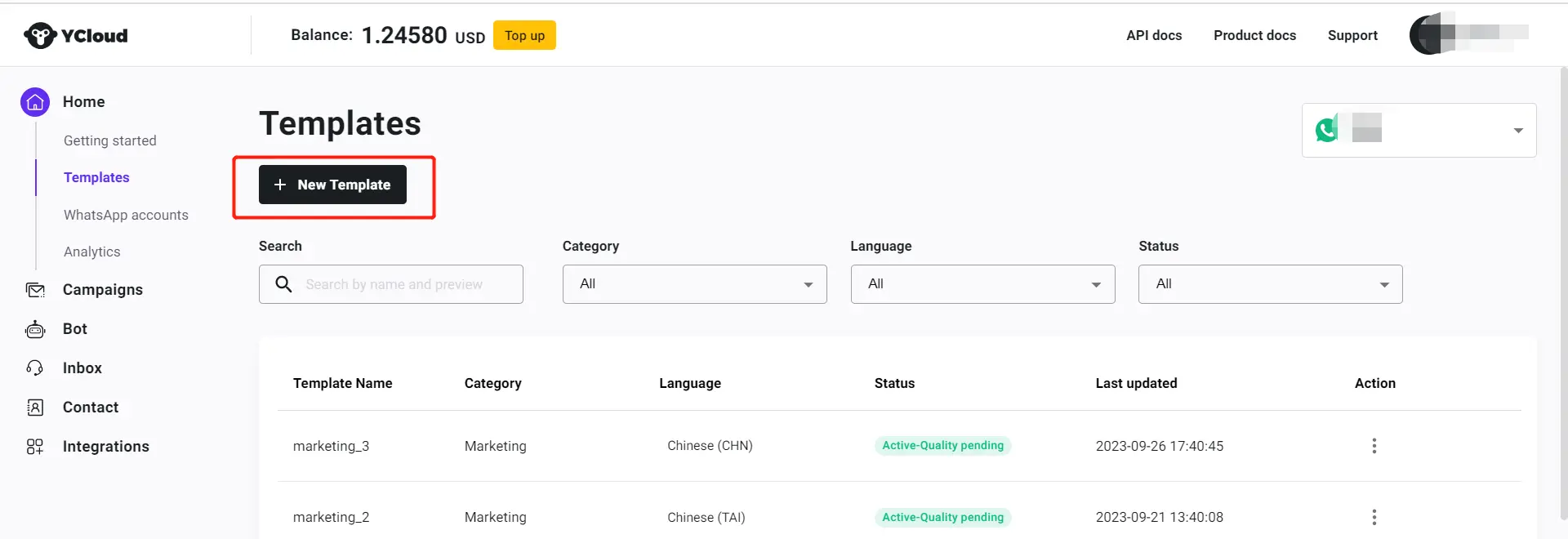Test sending WhatsApp messages
Important Notes Before Testing
Before formally testing WhatsApp messages, it's crucial to be aware of the rules for WhatsApp API accounts: Outside the 24-hour customer service window, your business can only send template messages that have been pre-approved by WhatsApp. Conversely, you can send non-template custom messages to users within the window.
In this tutorial, we will focus on proactively sending messages to users using template messages.
Create message templates
If you want to create message templates, please log in to your YCloud account, click "Home > templates". Then click to "+ New Templates"

On the next page, you can fill in the information and submit the template to WhatsApp. The WhatsApp team will use the information you provide to approve or reject the submitted template.
Template Name
The template name must be unique and can only contain lowercase alphanumeric characters and underscores. Use a descriptive and meaningful name that helps WhatsApp's reviewers understand the purpose of your message. For example, instead of "template_1," use "order_delivery."
Template Category
Select the category that best fits your use case:
- Marketing: Use this category to send promotional offers, product announcements, and other marketing-related messages to increase awareness and engagement.
- Authentication: Use this category to send secure codes that allow your customers to access their accounts.
- Utility: Use this category to send account updates, order updates, alerts, and other important information.
Message language
Select from the languages provided by WhatsApp.
Header(Optional)
Headers are optional. You can use headers to provide additional information to end users.
Headers can contain the following:
- Image (Recommended size: 1125px * 600px)
- Document
- Video
- Text (maximum of 60 characters, can include 1 placeholder)
Body
Enter the text for your message in the language you've selected. You can edit text formats, add emojis, or include variables.
Footer(Optional)
Add a short line of text to the bottom of your message template.
Buttons(Optional)
Select from the drop-down menu to create buttons that let customers respond to your message or take action:
- None: If you don't want to add any buttons, select this option.
- Call to Action: Create up to two buttons that allow your customers to take action. The types of action include "Call Phone Number" and "Visit Website." This lets you add a phone number or website URL to your message. If you choose "Visit Website," you can choose from a Static (fixed) website URL or a Dynamic website URL, which creates a personalized link for the customer to view their specific information on your website by adding a variable at the end of the link.
- Quick Reply: Create up to three buttons that let your customers respond to your message.
Before using any templates to message users, they must be approved by WhatsApp. Click the Submit button to send your template for approval.

Approval Period
Once you have created your template you can submit it for approval. It can take up to 24 hours for an approval decision to be made. Once a decision has been made, a notification will appear in your WhatsApp Manager and we will send an email to your Business Manager admins.
If your message template is approved, it's status will be set to Active - Quality pending and you can begin sending it to customers. If it is rejected, you can edit it and resubmit for approval, or appeal the decision.
Send template messages
Send messages by Campaign
Step-by-step guidance: https://docs.ycloud.com/docs/whatsapp-campaign-guide
- Log in to your YCloud account访问YCloud后台,点击访问
- As the below guidance show, click "Campaign" to create the message broadcast

Send messages by API
Guidance: https://docs.ycloud.com/reference/whatsapp_message-send
FAQ
Common reasons for template rejection: https://docs.ycloud.com/docs/message-templates
Appeal for Rejected Templates: https://business.facebook.com/accountquality/
Common Template Status References: https://docs.ycloud.com/docs/message-templates
Updated 4 months ago
